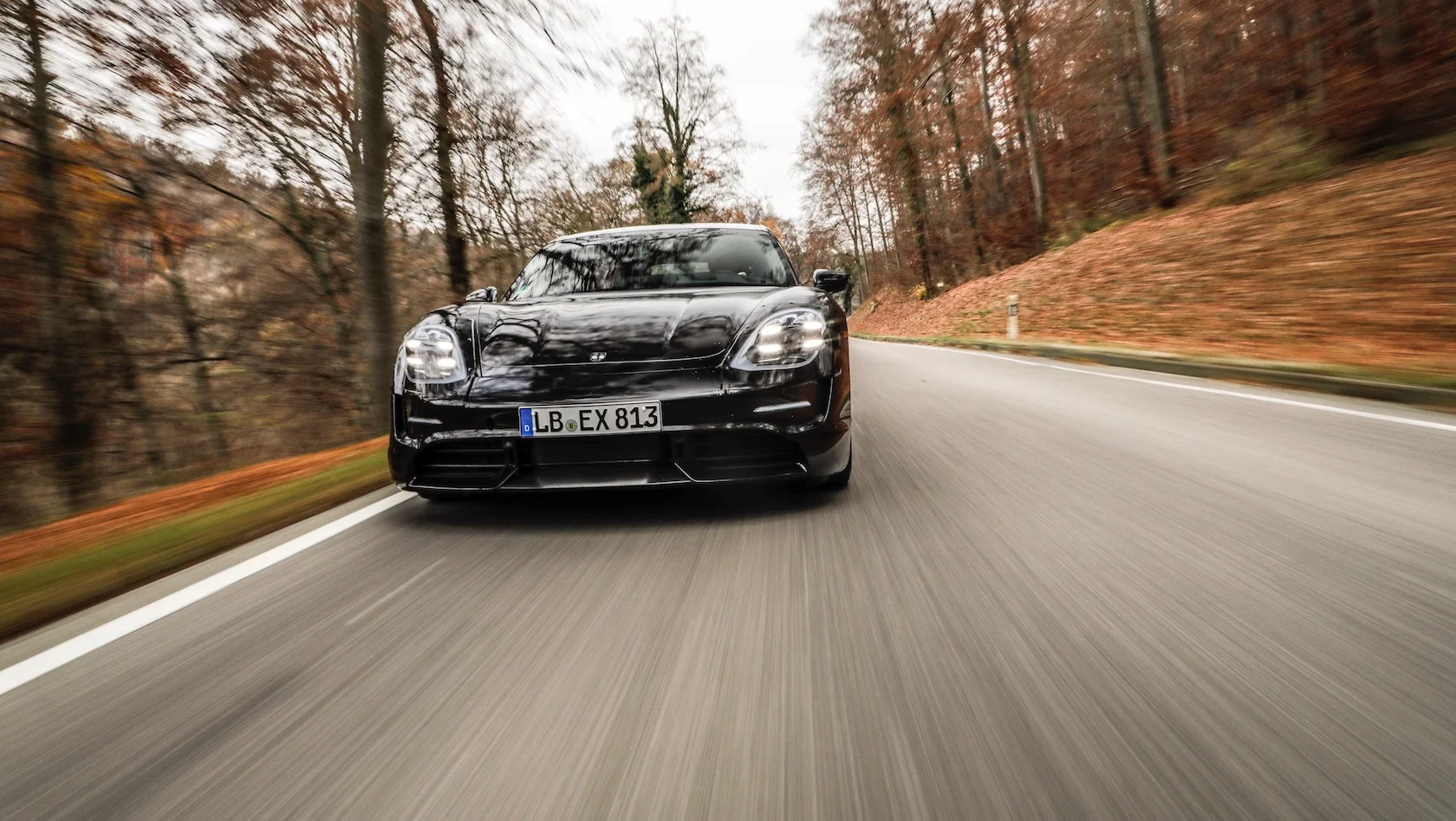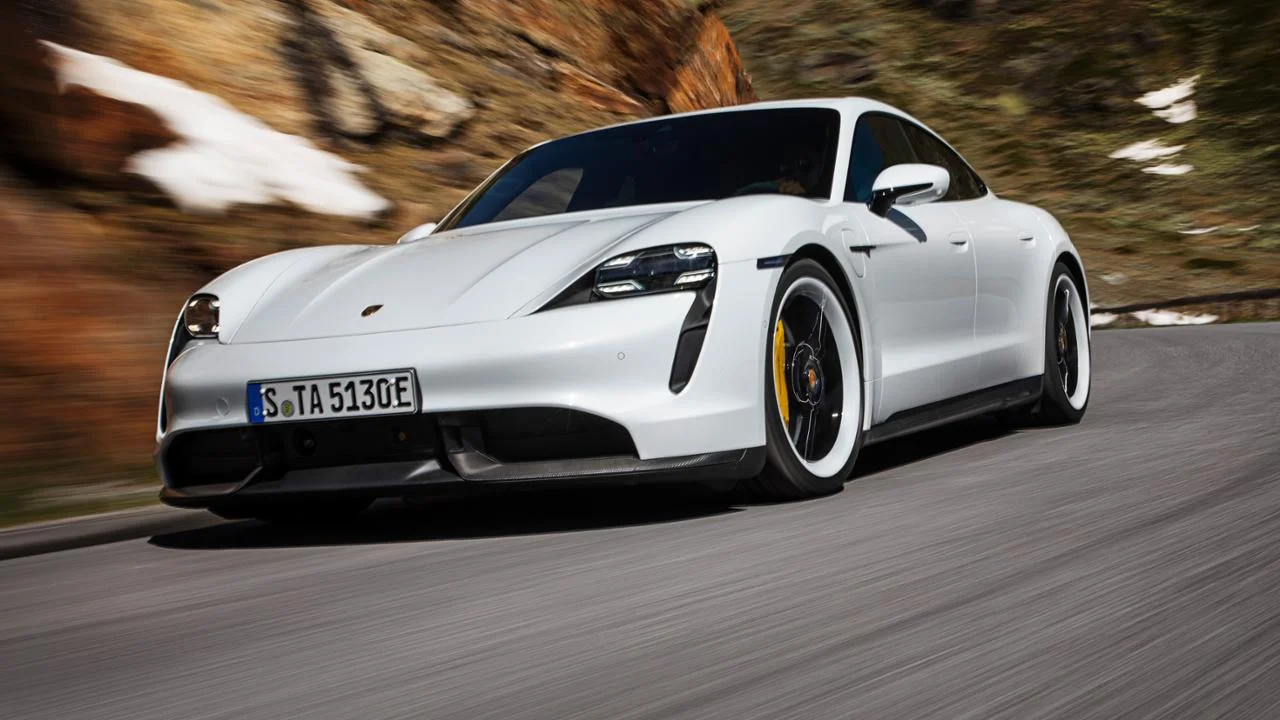First Drive Impressions: 2020 Porsche Taycan
The excellent YouTube channel Fully Charged has posted an exciting video in which UK journalist Jonny Smith, invited by Porsche, gives some first drive impressions of the 2020 Porsche Taycan. Porsche wanted to demonstrate the Taycan’s repeatability of performance and Jonny did over 30 full power launches to over 200 kph, each one taking about 10 seconds.
Walkaround
Jonny walks us around a lightly camouflaged Taycan but points out the details both fake and real. The overall shape is well known and I’d describe it generally as having a 911-style front mated to a four-door hatchback rear body. The hatch is powered. Three different wheel styles were being used on test vehicles at the shoot, at least one being 20 inches in size. Visible through the wheels the test car has the yellow calipers associated with the Porsche Carbon Ceramic Brake (PCCB) system, possibly with 410 mm rotors also available on the 911. This makes sense for a performance car weighing around two tons thanks to the 96 kWh battery.
Yellow calipers on the Taycan imply carbon ceramic brakes.
The car has active aerodynamics with a movable wing and vent doors. A “range button” optimizes the aerodynamics for maximum range, probably including lowering the car using the air suspension, and also probably doing the usual tricks of backing off on the throttle response and air conditioning load. This mode is apparently good for about a 10% increase in range. The upper portion of the brake light cluster extends onto the wing, an unusual design touch that might not be permitted in the US.
The Taycan has two charge doors, one on each front quarter panel. Similar to the motorized charge doors on the Audi e-Tron, they open upward with a hand gesture revealing an AC/DC port on the right side of the car, AC only on the left. Using that DC fast charging port at 250 kW can give you 0 to 80% charge in about 40 minutes. The stated range is about 320 miles (515 km) but that is surely on the World harmonized Light vehicles Test Procedure (WLTP) scheme, which would translate to about 285 miles on the US market EPA system. Given that, the 0-80% charge speed is about 384 mi/hr (WLTP), 343 mi/hr (EPA). Of course you’ll need to find an appropriate charger to do that. Electrify America has a network of chargers supporting up to 350 kW, so it’s not impossible now and getting better with time.
To keep weight down the bodywork is mostly aluminum with applications of carbon fiber and high-tensile strength steel. At two tons, weight is similar to the Panamera.
Drivetrain
The test car is AWD with approximately 600 hp split 200 front, 400 rear. This should give an enthusiast friendly rear bias in thrust while allowing for good traction and, critically, regenerative braking through the heavily loaded front tires. The launch version (“Turbo”) of the car is a high end specification, although probably not the highest, and will likely start at around US$160,000 according to Jonny. Knowing Porsche it is fair to say that a large variety of expensive options will be available. Future versions, Jonny speculates, will trend downwards with rear wheel drive, less powerful motors, and maybe smaller batteries aiming at an entry price of around US$80,000. That is, notably, significantly less than the starting price of the new 911 ($97,000). Look for those about a year and half after the Taycan goes on sale later this year.
Porsche confirms that the drive motors and battery are liquid cooled. Thermally managed is probably a better term, and the power management system is probably included as well. This is, Porsche says, a critical aspect of their repeatability of performance. “We sat out with the goal to build a Porsche and not have the driver feel the de-rating of the car in any situation,” a Porsche engineer states, obviously casting a bit of shade at Tesla.
Unusually for an electric, the Taycan has a two-speed transmission. The drive motors are permanent magnet synchronous.
From The Driver’s Seat
The hood is low and out of sight. The tops of the front wheel arches are the only parts visible to the driver, similar to a 911. Details of the interior are still under wraps although we know that the center console has haptic feedback capability. My guess is that it will push forward from recently Porsche interiors but the family resemblance will still be there.
Performance
Porsche will officially admit to 0-100 mph (0-62 mph) in “under 3.5 seconds.” Jonny thinks it will be a lot less than that, probably more like 3 seconds. (“Maybe,” says the Porsche engineer, cautiously.) This is still slower than a Tesla P100D but no special mode activations are required and the Porsche will do it again and again. Jonny did over 30 0-200 kph (0-124 mph) runs that day, each taking about 10 seconds. To activate launch control you apparently just hold the brake and floor the accelerator for a few seconds. Release the brake and you’re off. Again and again. As you accelerate you can hear the drivetrain and feel the traction control working to maximize thrust through all four tires.
Top speed, Porsche claims, is 250 kph (155 mph). This is suspiciously round and implies that it is being artificially limited.
The test facility, an airport in Germany, wasn’t set up as a handling course but Jonny says that you generally don’t feel the weight of the car. Porsche is very good at this sort of thing and I suspect they’re doing torque vectoring to help with that.
Conclusions
The Taycan looks very appealing. Tesla enthusiasts will probably point out the slightly lower acceleration and higher initial price compared to the Model S but the Taycan may be the more appealing package overall to the enthusiast driver or owner who prefers a less minimal interior or more normal ownership experience. The Tesla supercharger network is, of course, a major selling point but industry standard high-speed charging stations are becoming increasingly common. Taycan is launching into one of the most interesting segments of the automotive industry and, like the dawn of the jet age, the future looks awesome.
Jonny Smith’s full video is below and I highly recommend watching it.


